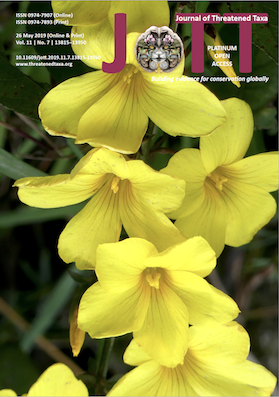Roadkill of animals on the road passing from Kalaburagi to Chincholi, Karnataka, India
DOI:
https://doi.org/10.11609/jott.4292.11.7.13868-13874Keywords:
Mammalia, seasonality, vehicular trafficAbstract
The road passing from Kalaburagi to Chincholi in Karnataka, India, is around 70km and is a state highway having different types of moderately thick vegetation on either side. The animals utilizing this vegetation face huge threats from vehicular traffic, as was observed in recent years. Although this road does not have heavy traffic, there are significant numbers of roadkills. This study was conducted from February 2015 to January 2016. During the one-year period of the study, the mean frequency of heavy vehicles was 154 per day. Among the 283 roadkills recorded, 52 individuals belonged to the class Amphibia, constituting 18.37% of the total roadkills; no amphibian was killed in the summer season whereas 35 and 17 individuals were killed in the rainy season and in the winter season, respectively. Fifty-two individuals belonged to the class Reptilia, constituting 18.37% of the total roadkills; on an average, 10±5.8 individuals were killed in the summer season, 2.5±0.71 in the rainy season, and 3.5±2.12 in the winter season. Sixty-one individuals belonged to the class Aves, constituting 21.55% of the total roadkills; on an average, 5.71±3.03 individuals were killed in the summer season, 2.66±2.08 in the rainy season, and 4.33±3.51 in the winter season. One-hundred-and-eighteen individuals belonged to the class Mammalia, which was the most affected among the roadkills, constituting 41.69% of the total roadkills; on an average, 5.33±5.08 individuals were killed in the summer season, 5±3.9 in the rainy season, and 4.6±2.7 in the winter season. Under the IUCN Red List category, the majority of the species in this study are considered Least Concern and some of them are not even mentioned. The present study helps to know the problems and threats faced by wild animals and is the first work carried out in the region.
References
Baskaran, N. & D. Boominathan (2010). Road kills of animals by highway traffic in the tropical forest of Mudumalai Tiger Reserve, southern India. Journal of Threatened Taxa 2(3): 753–759. https://doi.org/10.11609/JoTT.o2101.753-9
Clevenger, A.P. & A.V. Kociolek (2006). Highway median impact on wildlife movement and mortality: state of the practice survey and gap analysis. Technical Report. Department of Transportation, Sacramento, California, 118pp.
Daniel, J.C. (2002). The Book of Indian Reptiles and Amphibians. Oxford University Press, Bombay Natural History Society Bombay, India, viii+238pp.
Das, A., M.F. Ahmed, B.P. Lahkar & P. Sharma (2007). A preliminary report of reptilian mortality on road due to vehicular movement near Kaziranga National Park, Assam, India. Zoos’ Print Journal 22(7): 2742–2744. http://doi.org/10.11609/JoTT.ZPJ.1541.2742-4
Drews, C. (1995). Road kill of animals by public traffic in Mikumi National Park, Tanzania, with notes on baboon mortality. African Journal of Ecology 33(2): 89–100.
Fahrig, L., J.H. Pedlar, S.E. Pope, P.D. Taylor & J.F. Wegner (1995). Effect of road traffic on amphibian density. Biological Conservation 73(3): 177–182.
Gokula, V. (1997). Impact of vehicular traffic on snakes in Mudumalai Wildlife Sanctuary. Cobra 27: 26–30.
Grimmett, R., C. Inskipp & T. Inskipp (1998). Birds of Indian Subcontinent. Oxford University Press, London, 888pp.
Gruisen, J.V. (1998). Rajasthan. Tiger Link 4(1): 10–11.
Menon, V. (2003). A Field Guide to Indian Mammals. Dorling Kindersley (India) Pvt. Ltd., Delhi, 201pp.
Newmark, W.D., J.I. Boshe, H.I. Sariko & G.K. Mahumbule (1996). Effects of highway on large mammals in Mikumi National Park, Tanzania. African Journal of Ecology 34: 15–31.
Reijnen, R., R. Foppen, C.T. Braak & J. Thissen (1995). The effects of car traffic on breeding bird populations in woodland III: reduction of density in relation to the proximity of main roads. Journal of Applied Ecology 32(1): 187–202.
Ramesh, C.S. (2013). Mitigation Impact of National Highway-58 on Indian Primate, Hanuman Langur (Presbytis entellus) in Uttarkhand Himalayas. In: Proceedings of the 2013 International Conference on Ecology and Transportation (ICOET 2013). Scottsdale Arizona, United States, 14pp.
Richardson, J.H., R.F. Shore & J.R. Treweek (1997). Are major roads a barrier to small mammals? Journal of Zoology, London 243: 840–846.
Rosen, C. & C.H. Lowe (1994). Highway mortality of snakes in the Sonoran desert of Southern Arizona. Biological Conservation 68: 143–8.
Selvan, K.M., Natarajan Sridharan & Sajan John (2012). Roadkill animals on national highways of Karnataka, India. Journal of Ecology and the Natural Environment 4(14): 363–365.
Seshadri, K.S., A. Yadev & K.V. Gururaja (2009). Road kills of amphibians in different land use areas from Sharavathi River basin, central Western Ghats India. Journal of Threatened Taxa 1(11): 549–552. https://doi.org/10.11609/JoTT.o2148.549-52
Spellerberg, I.F. (2002). Ecological Effects of Roads. Science Publishers Inc., Enfield, 260pp.
Trombulak, S.C. & C.A. Frissell (2000). Review of ecological effects of roads on terrestrial and aquatic communities. Conservation Biology 14(1): 18–30.
Vijayakumar, S.P., K. Vasudevan & N.M. Ishwar (2001). Hepetofaunal mortality on the roads in the Anamalai Hills, southern Western Ghats. Hamadryad 26(2): 265–272.
Published
Issue
Section
License
Authors own the copyright to the articles published in JoTT. This is indicated explicitly in each publication. The authors grant permission to the publisher Wildlife Information Liaison Development (WILD) Society to publish the article in the Journal of Threatened Taxa. The authors recognize WILD as the original publisher, and to sell hard copies of the Journal and article to any buyer. JoTT is registered under the Creative Commons Attribution 4.0 International License (CC BY), which allows authors to retain copyright ownership. Under this license the authors allow anyone to download, cite, use the data, modify, reprint, copy and distribute provided the authors and source of publication are credited through appropriate citations (e.g., Son et al. (2016). Bats (Mammalia: Chiroptera) of the southeastern Truong Son Mountains, Quang Ngai Province, Vietnam. Journal of Threatened Taxa 8(7): 8953–8969. https://doi.org/10.11609/jott.2785.8.7.8953-8969). Users of the data do not require specific permission from the authors or the publisher.





